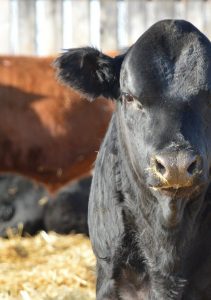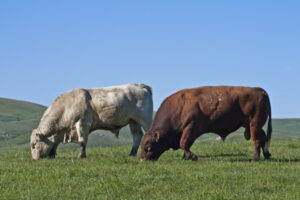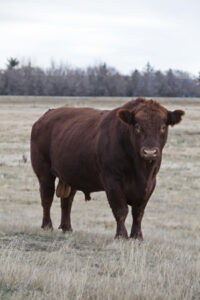Buying Power: Bull Selection to Improve Your Bottom Line
Remarque : cette page web n’est actuellement disponible qu’en anglais.
If it hasn’t happened already, soon your mailboxes and inboxes will be filling up with catalogues for this year’s bull sales. How can you identify which bull is going to work best for your operation? Purchasing the best bull for your operation’s needs starts with good record keeping to identify your operation’s strengths and weaknesses. From there you can work to narrow down your search based on your breeding system, genetic goals and budget. The following tips can help guide you in the process of purchasing your next herd sire.
It’s not one size fits all when it comes to bull buying
Breeding programs will be determined by operational goals and the management practices that fit those goals. A farm that auctions their calves at weaning may choose a crossbreeding program with high performance, while a farm that direct markets their beef may prefer the uniformity of a single breed.
There are many different types of bulls available, and effective sire selection requires an understanding of the available genetics as well as your own operation. Aiming for complementarity of the bull’s genetics to your current cow herd and fit with your operational goals will contribute to increased revenue and reduced costs.
Each breed of cattle has distinct traits that allow them to excel in different geographical or managerial environments. Depending on the goals of the operation, a sire can be chosen that has the potential to make positive changes for your operation in the areas you’ve identified for improvement. The following article provides more information on the types of breeding systems that may work for your operation.
Bull Selection: Breeding Programs that Suite Operational Goals (BCRC Blog post)
Consider both the short-term gain and the long-term investment
Bull selection is one of the most important decisions for cow-calf producers, with implications for short- and long-term profitability of the operation. The choice of bull can be immediately seen in the subsequent calf crop. If the operation retains heifers and/or bulls, the genetics in the selected bull will be passed down to subsequent generations. Introducing new genetics is a permanent change to the herd, compared to the temporary nature of supplements or management practices. As such, bull selection can be seen as a long-term investment into the operation.
Research in the area of beef cattle genetics has been growing significantly. There are opportunities to improve profitability through sire selection. However, with a multitude of traits, breed differences, operational goals, and management practices, bull selection is a complex decision.
Bull Selection: What are You Looking For? (BCRC Blog post)
Narrow down your search
Given the plethora of EPDs available, trying to sort through ten or twenty individual EPDs that may not have relevance to your particular operation can easily lead to information overload, many breed association provide selection indexes that combine multiple traits with relevant weightings in order to combine several traits of interest into one number. By focusing on Economically Relevant Traits (ERTs), you can eliminate those bits of information that will not directly impact your operation’s profitability. Economically relevant traits are those that are directly associated with a source of revenue, or a cost. Not all EPDs represent ERTs – instead they use a related (or indicator) trait to estimate the ERT.
One of the best examples is birth weight. Decreasing a bull’s birth weight by 5 lbs does not have any associated income or costs but is often used as a bull buying criteria in an effort to reduce calving problems.
Bull Selection: Using Economically Relevant Traits (BCRC Blog post)

Getting your money’s worth
Identifying a fair price during sire selection contributes to higher efficiency in operational economics. To estimate breakeven bull price, a bull valuation calculator has been developed. The purpose is to provide a general idea of how much a bull is worth based on key farm parameters.
The value a bull provides depends on his individual performance, the environment (.g., pasture productivity), management (cow:bull ratio) and markets (calf price). For example, large framed bulls require more feed, leading to a higher maintenance cost, but that may be offset by heavier calves at sale time.
A bull’s value is delivered through the calves sired over a lifetime, the long-term genetic change of the herd, and salvage value at the end of a productive life.
The value provided depends on:
- cost factors (i.e., bull maintenance cost and death loss),
- performance factors (i.e., years of service, the expected cow to bull ratio, expected weaning rate, expected weight of feeders, and proportion of the calf value attributed to the bull), and
- price factors (i.e., expected price of feeders and salvage value).
Learn more about the bull valuation calculator and to try your own numbers visit the following blog post:
Bull Selection: New Calculator to Determine the Value of Bull (BCRC Blog post)
Click here to subscribe to the BCRC Blog and receive email notifications when new content is posted.
The sharing or reprinting of BCRC Blog articles is welcome and encouraged. Please provide acknowledgement to the Beef Cattle Research Council, list the website address, www.BeefResearch.ca, and let us know you chose to share the article by emailing us at info@beefresearch.ca.
We welcome your questions, comments and suggestions. Contact us directly or generate public discussion by posting your thoughts below.


